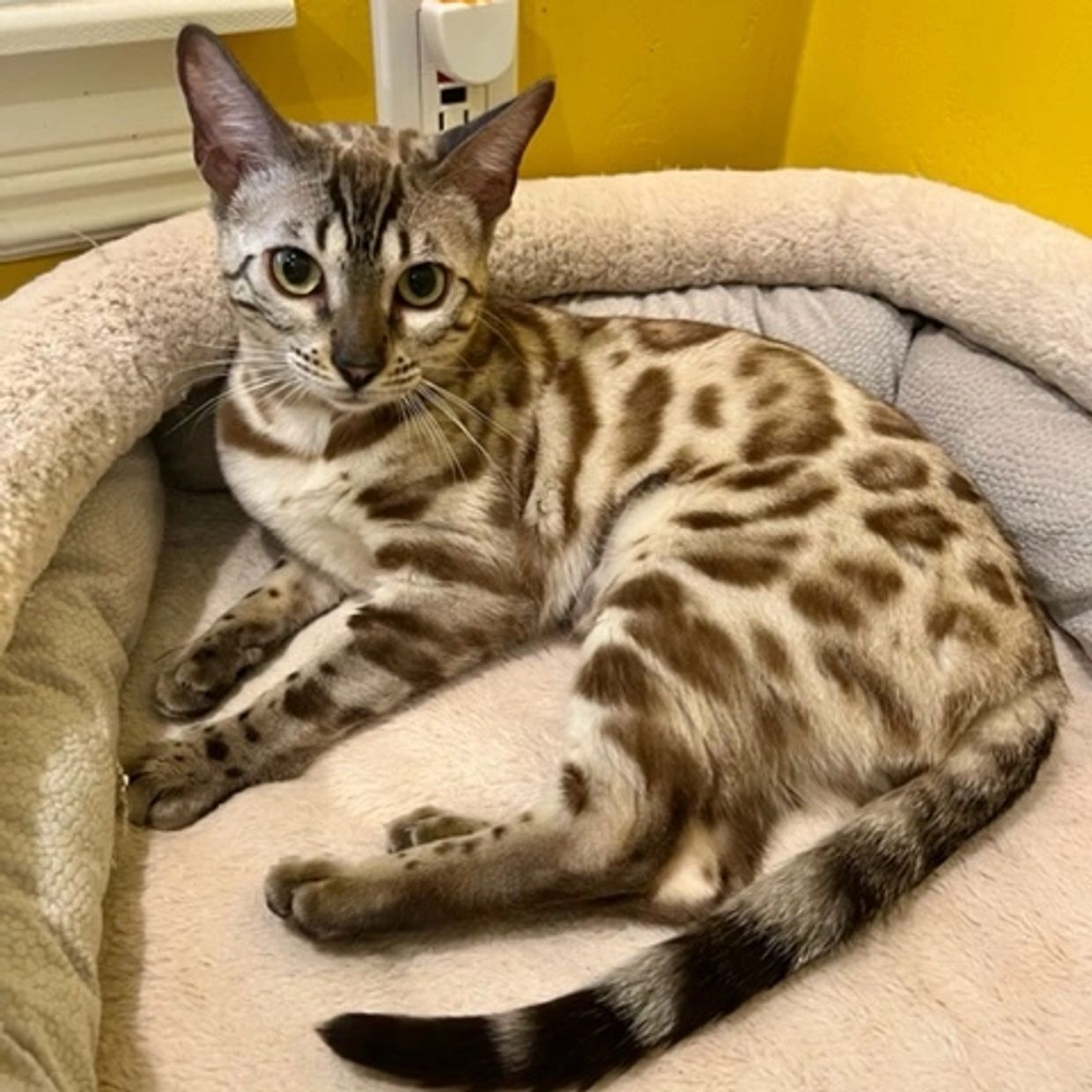Key Takeaways
-
Bengal cats are highly energetic and require significant mental and physical stimulation.
-
Adopting a Bengal cat can be more affordable than purchasing from a breeder, but ongoing costs are still substantial.
-
Bengal cats can coexist well with other pets if properly socialized.
-
They have unique care requirements, including specialized diets and regular vet visits.
-
Understanding their behavior and needs is crucial for a successful adoption experience.
Adopt Bengal Cat Rescue
Adopting a Bengal cat from a rescue can be a rewarding experience, both for you and the cat. These cats are known for their stunning appearance and playful nature, making them a popular choice among cat enthusiasts. However, it’s essential to understand the commitment involved in caring for a Bengal cat before bringing one into your home.

“Rescue Adult Bengals” from exoticbengalsd.com and used with no modifications.
Bengal Cats: An Overview
Bengal cats are a hybrid breed, developed by crossing domestic cats with the Asian Leopard Cat. This gives them their distinctive spotted or marbled coat, which resembles that of a wild leopard. They are medium to large-sized cats, with males typically weighing between 10-15 pounds and females between 8-12 pounds.
Their physical appearance isn’t the only thing that sets them apart. Bengal cats are known for their high energy levels and intelligence. They thrive on interaction and need plenty of mental and physical stimulation to stay happy and healthy. Without proper engagement, they can become bored and may develop behavioral issues.
Bengal Cat Misconceptions
There are several misconceptions about Bengal cats that potential adopters should be aware of, similar to those about other pets like the Amazon parrot.
-
Wild Temperament: Despite their wild ancestry, Bengal cats are domestic and can be very affectionate and social with proper training and socialization.
-
High Aggression: Bengal cats are not inherently more aggressive than other cat breeds. Aggression is often a result of lack of stimulation or improper socialization.
-
Unsuitable for Families: Bengal cats can be great family pets if they are introduced to children and other pets gradually and respectfully.
Pros and Cons of Adopting a Bengal Cat
Like any pet, Bengal cats come with their own set of advantages and disadvantages. Understanding these can help you make an informed decision.
Pros
-
Beautiful Appearance: Their unique coat patterns make them one of the most visually striking cat breeds.
-
Intelligent and Trainable: Bengals can learn tricks, use a leash, and even play fetch. Their intelligence makes them highly trainable.
-
Active and Playful: If you enjoy an active pet, a Bengal cat’s playful and energetic nature can be a perfect match.
Cons
-
High Energy Levels: Their need for constant stimulation can be demanding for some owners.
-
Potential for Destructive Behavior: Without enough mental and physical activities, Bengals can become destructive.
-
Specialized Care Requirements: Bengals may require a specific diet and regular veterinary care to maintain their health.
Key Considerations Before Adopting
Before you decide to adopt a Bengal cat, there are several key factors to consider, such as their need for specialized care. For example, if you’re considering a different breed, you might want to read about the American Curl cat and its specific needs.
Time Commitment
Bengal cats are not the type of pet that can be left alone for long periods. They need daily interaction and playtime to keep them mentally and physically stimulated. If you have a busy lifestyle, you may need to reconsider or find ways to ensure your Bengal cat gets the attention it needs.
Space Requirements
Because of their high energy levels, Bengal cats require ample space to explore and play. If you live in a small apartment, you might need to invest in vertical space solutions like cat trees and shelves to give them room to climb and jump. For more information on the costs associated with owning a Bengal cat, you can check out this detailed guide.
Compatibility with Other Pets
Bengal cats can get along well with other pets, but it depends on their individual personalities and how they are introduced. Proper socialization is crucial. Start by introducing them to other pets gradually and under controlled conditions to ensure a smooth transition.
Remember, every pet is different. Some Bengals may be more territorial, while others are more social. Pay attention to their body language and adjust your approach accordingly.
High Maintenance or Manageable?
Many people wonder if Bengal cats are high maintenance. The answer depends on your perspective and lifestyle. Bengals do require more attention and care compared to some other cat breeds, but they are also incredibly rewarding companions. If you’re interested in other breeds, you might want to check out the American Curl cat for comparison.
Energy Levels
Bengal cats are known for their high energy levels. They love to play, run, and explore. To keep them happy, you need to provide plenty of toys, interactive play sessions, and opportunities for exercise. Consider puzzle feeders, laser pointers, and feather wands to keep them engaged. Regular playtime is essential to prevent boredom and destructive behavior. If you’re interested in other active pets, you might want to learn about Campbell Dwarf Russian Hamster adoption.
Special Care Requirements
Bengal cats have specific care needs that you should be prepared to meet. They often have sensitive stomachs and may require a specialized diet. High-quality, grain-free cat food is usually recommended. Additionally, regular veterinary check-ups are crucial to monitor their health and catch any potential issues early.
Another important aspect of Bengal care is grooming. While they have short coats that don’t mat easily, they do shed. Regular brushing can help keep their coat healthy and reduce shedding around the house.
Behavior and Temperament
Bengal cats are known for their playful and affectionate nature. They form strong bonds with their owners and enjoy being involved in family activities. However, their high energy levels can sometimes lead to mischievous behavior if they don’t get enough stimulation. If you are interested in other playful pets, consider learning about the Abyssinian Satin Guinea Pig.
It’s essential to understand that Bengals are intelligent and curious. They need mental challenges to keep them occupied. Providing a variety of toys and changing them regularly can help keep your Bengal mentally stimulated.
Socialization Needs
Proper socialization is key to a well-behaved Bengal cat. Expose your Bengal to different people, environments, and experiences from a young age. This helps them become more adaptable and reduces the likelihood of fear-based behaviors. For more information on cat breeds, you might find the American Curl Cat Rescue article interesting.
If you adopt an older Bengal, don’t worry. Socialization is still possible. Take things slow and be patient. Use positive reinforcement to reward calm and friendly behavior.
Adaptability to Households
-
Families with Children: Bengals can be great with children if introduced properly. Teach kids how to interact with the cat gently and respectfully.
-
Single-Pet Households: Bengals can thrive as the only pet, especially if they get plenty of attention and interaction from their owners.
-
Multi-Pet Households: With proper introductions and socialization, Bengals can coexist with other pets. Monitor interactions and provide separate spaces if needed.
Bengal cats are adaptable and can fit into various household types, but their needs must be met to ensure a happy and healthy life.
Training Tips
Training a Bengal cat can be a fun and rewarding experience. Their intelligence and curiosity make them quick learners. Here are some tips to help you train your Bengal:
-
Use Positive Reinforcement: Reward your Bengal with treats, praise, or playtime for good behavior. This encourages them to repeat the desired actions.
-
Be Consistent: Consistency is key in training. Use the same commands and rewards each time to help your Bengal understand what is expected.
-
Start Early: The earlier you start training, the better. Kittens are more adaptable and open to learning new behaviors.
-
Keep Sessions Short: Short, frequent training sessions are more effective than long, infrequent ones. Aim for 5-10 minutes at a time.
Training not only helps manage your Bengal’s behavior but also strengthens the bond between you and your cat. Enjoy the process and celebrate the progress!
Final Thoughts on Bengal Cat Adoption
Adopting a Bengal cat from a rescue can be a deeply rewarding experience. These cats are not only stunning to look at but also offer a unique blend of intelligence, playfulness, and affection. However, they do come with their own set of challenges, including high energy levels and specific care requirements.
Understanding what you’re getting into is crucial. Bengal cats need a lot of attention, mental stimulation, and physical activity. They can be a bit high-maintenance compared to other breeds, but for the right person or family, the rewards far outweigh the challenges. If you’re prepared to meet their needs, a Bengal cat can make a wonderful addition to your home.
Frequently Asked Questions (FAQ)
Are Bengal cats suitable for families with children?
Yes, Bengal cats can be great with children. They are playful and energetic, which can make them excellent companions for kids. However, it’s essential to teach children how to interact with the cat gently and respectfully. Supervise interactions initially to ensure both the cat and the child are comfortable and safe.
How do Bengal cats get along with other pets?
Bengal cats can get along well with other pets, but it depends on their individual personalities and how they are introduced. Proper socialization is key. Start by introducing them to other pets gradually and under controlled conditions. With time and patience, Bengals can coexist peacefully with dogs, other cats, and even smaller pets.
What kind of diet is best for Bengal cats?
Bengal cats often have sensitive stomachs and may require a specialized diet. High-quality, grain-free cat food is usually recommended. Consult your veterinarian to determine the best diet for your specific Bengal cat. Regular veterinary check-ups are also crucial to monitor their health and make any necessary dietary adjustments.
Do Bengal cats require a lot of grooming?
While Bengal cats have short coats that don’t mat easily, they do shed. Regular brushing can help keep their coat healthy and reduce shedding around the house. Occasional baths may also be necessary, especially if your Bengal gets into something messy. Overall, their grooming needs are relatively low compared to long-haired breeds.


